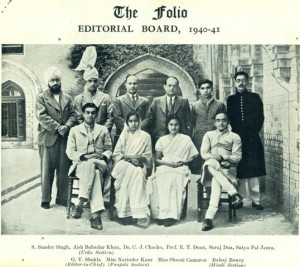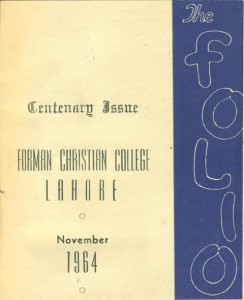The Folio can rightly claim to be the oldest college magazine in West Pakistan. Its inaugural issue came out in November 1903. It was then a monthly publication containing about thirty pages. Annual subscription was fixed at Rs. 4 for students of the college and Rs. 3 for members of the Graduates Association, as the Alumni Association was then known.
The magazine at that time was known by the simple name of the F. C. College Monthly and it was managed exclusively by the members of the teaching staff, who hastened to assure their readers that the bringing out of this journal was “not an aimless task”. “The college staff,” says an editorial note, “is not suffering in the least from lack of work. All are very busy men but so earnest is their desire to supplement the work of lecture room by perpetuating, in a sense, the relation which they bear to the pupils here that they most cheerfully assume this additional burden.”
The staff members in charge of this publication, who chose to remain anonymous, laid down that the policy of the journal shall be “to speak the truth in love and to abstain scrupulously from anything savouring of harshness and uncharitableness in our judgements of opinions of others who honestly differ from ourselves”. This, in the year 1903, must have seemed downright radical. The main aim was, however, confined to enabling old students to keep themselves in touch with the college and its work. Expectations and hopes were realistic and pragmatic rather than enthusiastic. “Should experience prove that we can be helpful to graduates, undergraduates and other English speaking gentlemen of North India, the task now undertaken will be one of very genuine delight.”
The magazine, apart from a few articles, contained some regular features like news about old boys, current life of the college, “science” and “notes and comments” which consisted of commentaries on various happenings at home and abroad. In the first issues, there was a note on the Investiture of the Nawab of Bahawalpur. Another ran like this: “We witness with dismay that at parties where Indians are the host and Europeans are guests a liberal supply of intoxicants is provided.” There were also comments upon the struggle in England between Free Traders and the Protectionists, the fact that MA English classes have been started in both F. C. and Government Colleges and “the hope that cordiality will prevail between the two colleges without the objectionable spirit of rivalry”.
There was also a small article on Wireless Telegraphy which began: “By improving his ingenuous apparatus, Signor Marconi has made considerable progress in sending messages (called Marconigrams) without the aid of wires.”
The column about college activities mentions the Cosmopolitan Society which “meets every Saturday in Dr. Griswold’s lecture room and whose subscription is one anna per month”. There were two clubs, the Gladstonians and the Academical Society. On 14th November 1903, they held a discussion on the proposition: “Resolved that Lord Curzon’s administration merits the approval of the people.”
Subsequent issues of the Folio were more lively and the quality of the contents improved. It is in fact an anthology on the life of the college and the city of Lahore. It faithfully followed the changes undergone by the city over these years. As we go through its files, we can visualise new buildings rising and the whole city being overhauled and renovated.
A note on the Convocation ceremony of the College in 1904 proudly mentions that there was an unusually large number of men receiving degrees this year. The number was 8 MAs, 12 BAs, 2 BScs. An article informs us about Mr Edison’s Miracle, meaning, electricity.
Political consciousness, of sorts, must have been very high, at least in Newton Hall whose residents, according to a 1905 issue, sent a telegram of congratulations to the Japanese Government on their great naval victory against Russia.
In November 1905 came a short break in the publication of the magazine as the editors felt that it was not fulfilling its original purpose of maintaining contact with old boys. But it came out again as a periodical instead of a monthly magazine, the frequency now being once or twice a year. This time there was no subscription although contributions, in monetary terms, were quite welcome. It was then known as the F. C. C. Notes.
The issue of January 1908 describes the inauguration of the Trans-Atlantic Wireless Telegraph Service along with a statement from Mr Marconi which said, “We handled a few stock exchange reports today but do not want any private messages. Later we may handle some press reports.”
In the next issue the editor describes a visit to the Badshahi Mosque. “On the day of Iduz Zuha we stood over the great gate of Badshahi Mosque and witnessed the spectacle of the serried ranks of Islam bowing down in silent adoration to God. The hush of that great prayer assembly, its order, the spectacle of thousands upon their faces before God and their evident sincerity, all this was most impressive. We could not but thank God for every element of vital religion which belongs to Islam.”
The magazine records the staging of Shakespeare’s comedy “As you Like It” in January 1910 by the students and alumni of the college. There is a reference, in the same issue, to an old tradition of the college … the ten minute tea break during college hours when all staff members collect in the staff room and gossip over a cup of tea. The editor, on a visit to the staff room, was presumably entertained and he was duly impressed, for he says, “The F. C. C. staff is one of the most homogenous and closely knit bodies of professors to be found anywhere in the world.” We wish the writer had said something about the quality of the tea also. Perhaps it was better then, or perhaps he was too polite.
The magazine again became a monthly publication in October 1913 and its annual subscription was fixes at Rs. 2 and 8 annas. Another change came about in 1915 when for the first time student editors were appointed. The very next year the student editors editorially complained that the journal was becoming too professional (they did not elaborate), and that it was too little a students’ publication. The change, however, resulted in the introduction of a few new features, one of them was “Question and Answers” This column, of which editors were quite proud, had its own weak and strong points. Sample:
Question: Prove that if the straight lines bisecting the base angles of a triangle and meeting the opposite sides are equal, the triangle is isosceles.
Answer: Will some Math student help us in solving it?
While such illuminating answers were given, the editors wondered why the magazine was not becoming popular and only 800 copies were sold among students and the alumni.
The magazine was initially an English language magazine. In the issue of October 1912, the first Urdu article written by Professor Molvi Muhammad Baqir was published. There was a full-fledged Urdu supplement in the issue dated December 1912. Among those whose names appear in the subsequent issues of the magazine as editor or as contributors are Mr N. M. Khan, Mr Mumtaz Hasan, Mr Abdul Qadir, Dr Ashiq Hussain Batalvi, Dr M. D. Taseer and Professor M. S. Bhatty who wrote some very spirited and humorous articles the very titles of which suggested a touch of originality. One was titled “In Defence of the Beard”.
We almost forgot. There were advertisements too. In a 1925 issue we find a full page advertisement for “Laundry Soap” which could be purchased from the F. C. College Chemistry laboratories “at reasonable prices”.
In November 1922, suggestions were invited for a better name for the magazine. But the matter was not pursued, probably for lack of good suggestions. In January, 1935, however, the name was changed to The FOLIO. The editors did not feel too enthusiastic about the new name, as indicated by the following explanatory note:
The history of the name is as involved as the movement in its favour. Yet we are implacably smug. The Folio is a fait accompli. Our predecessors have tilted official windmills. Names have sprung up like dragon’s teeth. “The Forman” appeared reasonable, but retired into oblivion for that very reason. “Gargoyles” was favoured, but the subeditor is suspicious of the sensational. The fittest, therefore, survived. It is not long when The Folio will be an institution which the abstract “Forman Christian College Magazine” could never be.
The cover of the new magazine, an impression of which will be found on various pages in this issue, was designed by Mr B. Sanyal of the Mayo School of Arts.
The Hindi supplement was added in 1928 and it was soon joined by supplements in Panjabi and Gurmukhi. The Urdu supplement was, for a few issues, published in Roman script but it did not become popular and was discontinued. A regular feature in those days was the News from Old Boys. Former students loved to write to their alma mater about laurels won by them, just as they would write to their own homes. One report in 1929 said, “Mr Nasir Ahmed writes from Oxford that he has just been awarded his college colours for hockey.”
The editors took special delight in having a dig at various societies of the college. A favourite target was the Music Club. “Some fatality seems to have been attached,” says a note in 1929, “to the function of this club as three attempts to hold it have failed.” An editorial in 1934 laments that the societies do practically nothing but “feast and photograph societies”.
A 1938 issue mention a camp organised on 3rd March, which is Founder’s Day, at the new site. The camp was probably organised every year on 3rd March at the Ferozepur Road site and it was discontinued only after the shifting of the college to this place. A basketball match was played between the students and the staff and was won by the staff. In the same issue there is complaint that in the posters about a Music Society function it was announced that all the great artists of India would participate, but actually none of them turned up.
Two new societies, the International Relations Club and The Scrolls are mentioned in a 1939 issues. The Scroll aimed at encouraging students to write and think independently. Dr S. L. Sheets was in charge.
When the college shifted to its present site, it inspired many a nostalgic piece of literature. A typical piece was a poem entitled “To The Old site Building”. Its opening lines were:
“O dear, dear old site, haunt of fifty years,
Let’s bid thee a last goodbye ’fore we depart
Like lovers’ parting wave are they recede
For everyone. O how it pains our hearts
To leave thee to the tread of foreign feet.”
Pure nostalgia, it seems. But well…
The new site, not unnaturally, looked drab and cheerless, but, as an editorial side, let visitors come on a moonlit night; they would be ushered into a dreamworld.
The Folio also reports celebrating the Silver Jubilee of the Lucas Economics Society in 1942. The Convocation of the year 1944 is noted by the Folio for a particular reason. The College Mess Department, says a note, bade farewell to its previous traditions and supplied a good lunch.
The rivalry between Griswold Hall and Newton Hall in the spheres of activities also does not go unnoticed. In many reports the Griswold Hall secretary signs “The Sworn Enemy of Newton Hall”. The Newton Hall secretary returns the compliment by signing “Constant Thorn in the Flesh of Griswold Hall”. A Griswold Hall song was also composed. Whatever its poetic merits, it is undoubted enthusiastic. We reproduce it for the sake of record:
We are the guys of Griswold Hall,
Griswold Hall, Griswold Hall, Griswold Hall,
We are the guys of Griswold Hall,
That’s our call, that’s our call,
We will be true to Griswold Hall,
Work and play,
All the day,
Merry, merry lads are we, Ho
Merry, merry lads are we, Ho.
After independence in 1947, the frequency of the publication of the Folio was reduced to once a year. Nevertheless, it continues to grow and improve in quality and, what is much more important, reflect the personality of this institution. Being so recent, it is too early to detail and evaluate the work done by this journal in the post-independence period but we can, with all modesty, claim to have remained true to the principles laid down in the first editorial in 1903:
“We shall aim to tell you of some of things most surely believed amongst us; and this we shall endeavour to do in a spirit of perfect candour, kindliness and charity.”
Source (including images): The Folio Centenary Issue, Forman Christian College, November 1964.



